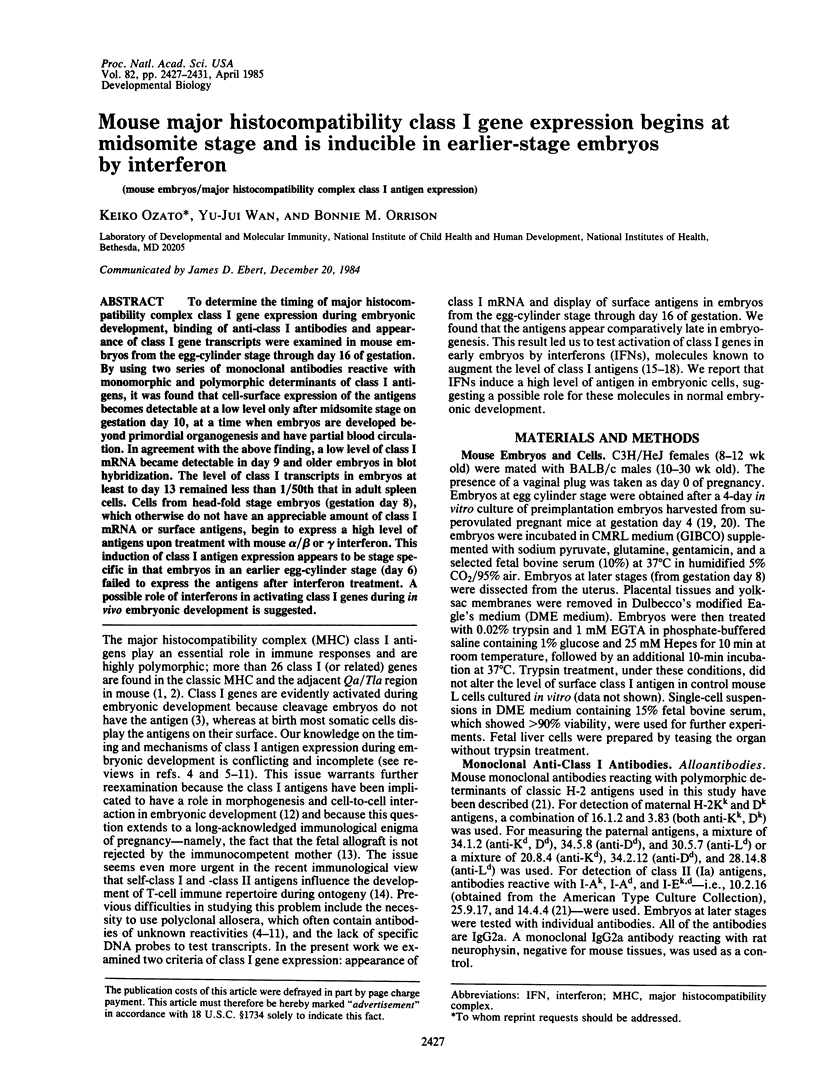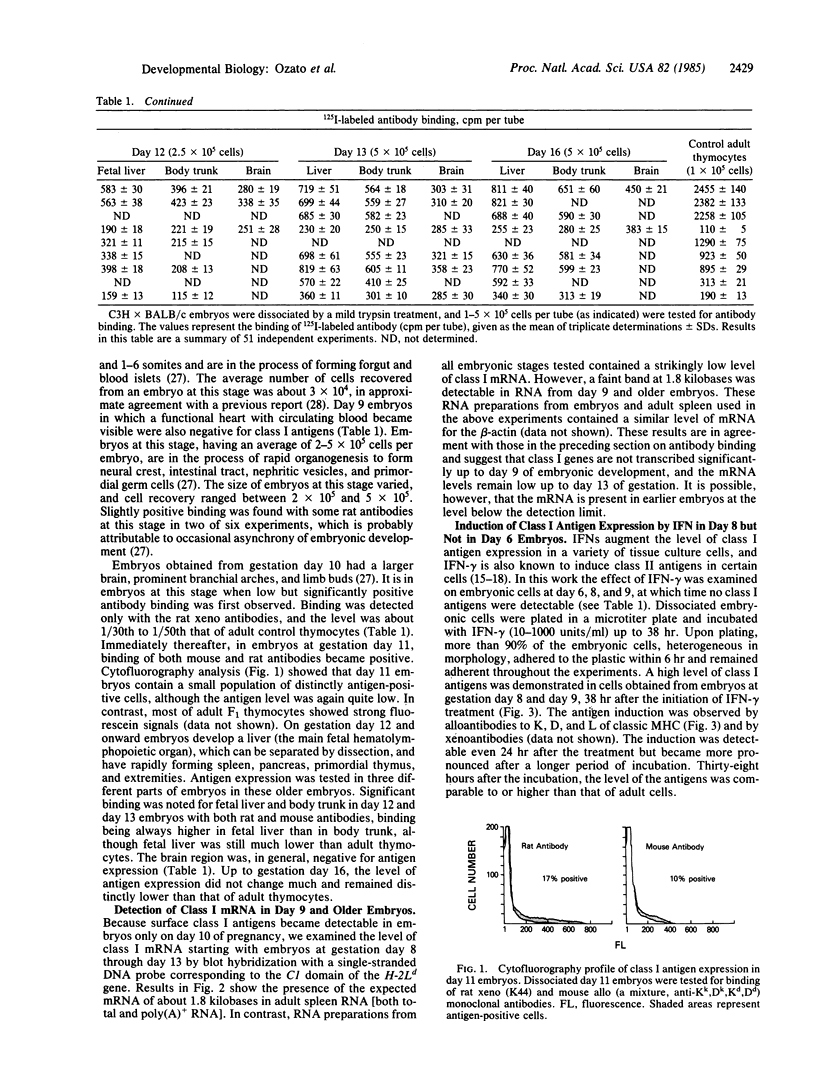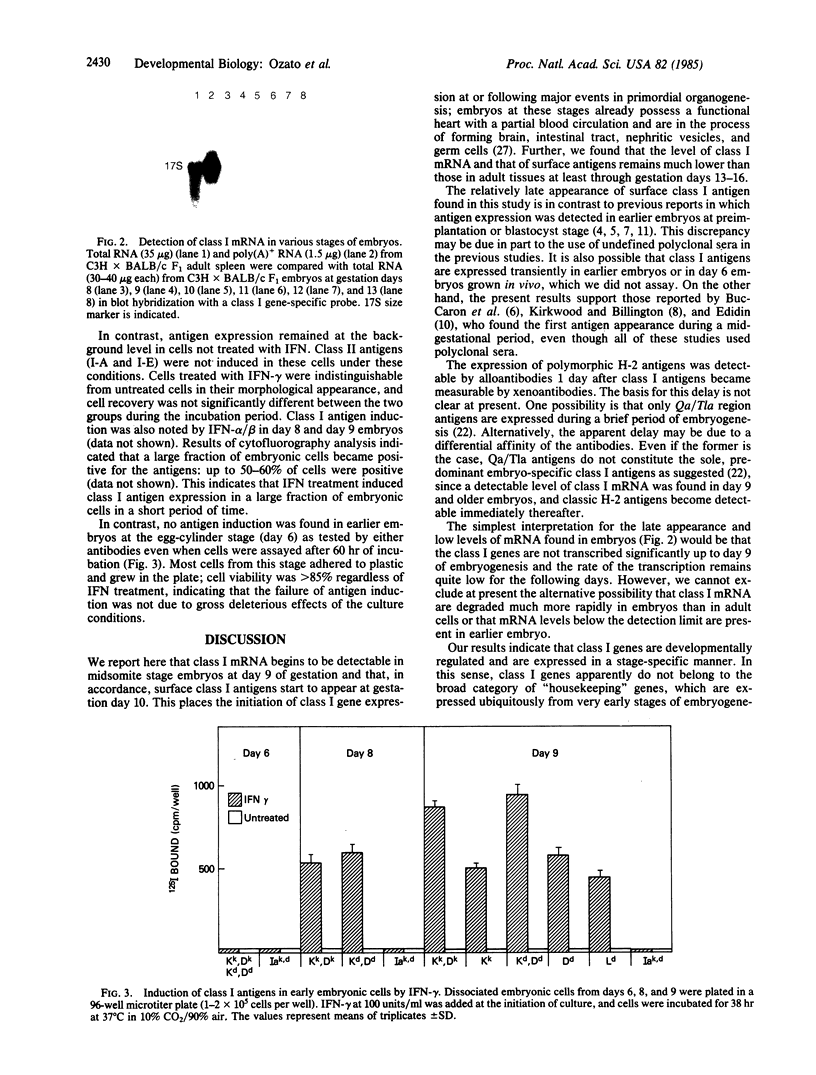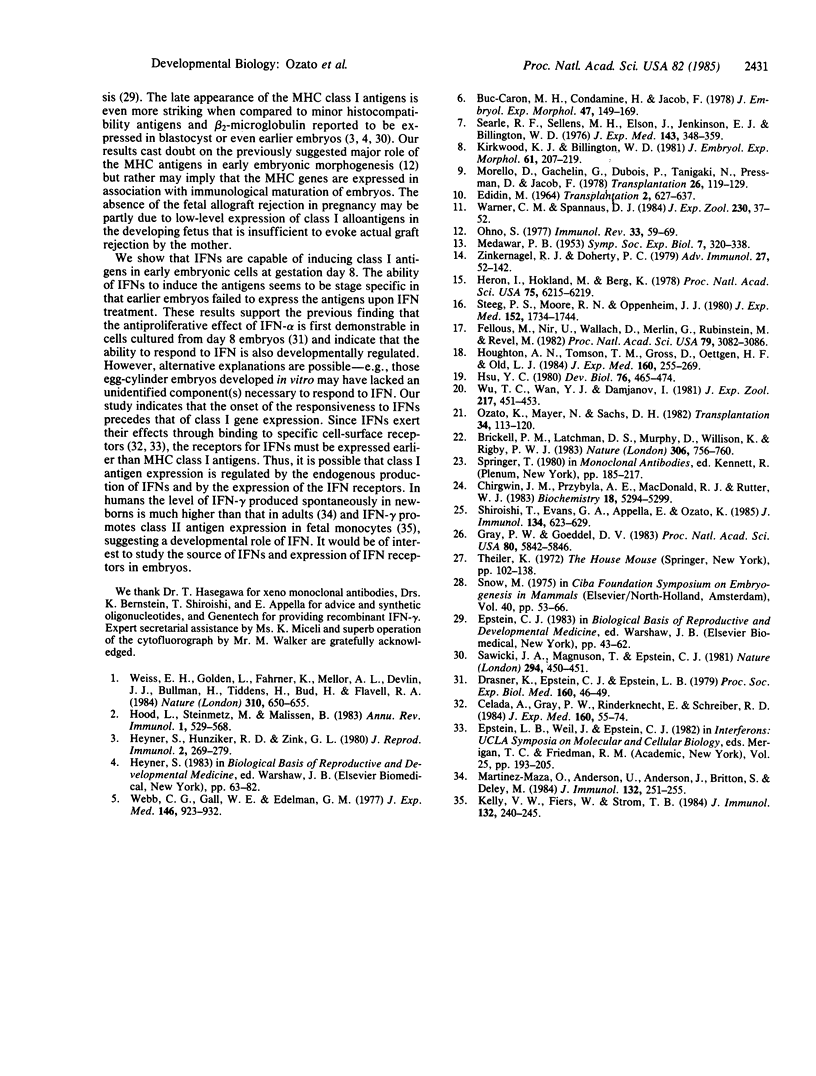Abstract
To determine the timing of major histocompatibility complex class I gene expression during embryonic development, binding of anti-class I antibodies and appearance of class I gene transcripts were examined in mouse embryos from the egg-cylinder stage through day 16 of gestation. By using two series of monoclonal antibodies reactive with monomorphic and polymorphic determinants of class I antigens, it was found that cell-surface expression of the antigens becomes detectable at a low level only after midsomite stage on gestation day 10, at a time when embryos are developed beyond primordial organogenesis and have partial blood circulation. In agreement with the above finding, a low level of class I mRNA became detectable in day 9 and older embryos in blot hybridization. The level of class I transcripts in embryos at least to day 13 remained less than 1/50th that in adult spleen cells. Cells from head-fold stage embryos (gestation day 8), which otherwise do not have an appreciable amount of class I mRNA or surface antigens, begin to express a high level of antigens upon treatment with mouse alpha/beta or gamma interferon. This induction of class I antigen expression appears to be stage specific in that embryos in an earlier egg-cylinder stage (day 6) failed to express the antigens after interferon treatment. A possible role of interferons in activating class I genes during in vivo embryonic development is suggested.
Full text
PDF




Images in this article
Selected References
These references are in PubMed. This may not be the complete list of references from this article.
- Brickell P. M., Latchman D. S., Murphy D., Willison K., Rigby P. W. Activation of a Qa/Tla class I major histocompatibility antigen gene is a general feature of oncogenesis in the mouse. Nature. 1983 Dec 22;306(5945):756–760. doi: 10.1038/306756a0. [DOI] [PubMed] [Google Scholar]
- Buc-Caron M. H., Condamine H., Jacob F. The presence of F9 antigen on the surface of mouse embryonic cells until day 8 of embryogenesis. J Embryol Exp Morphol. 1978 Oct;47:149–160. [PubMed] [Google Scholar]
- Celada A., Gray P. W., Rinderknecht E., Schreiber R. D. Evidence for a gamma-interferon receptor that regulates macrophage tumoricidal activity. J Exp Med. 1984 Jul 1;160(1):55–74. doi: 10.1084/jem.160.1.55. [DOI] [PMC free article] [PubMed] [Google Scholar]
- Chirgwin J. M., Przybyla A. E., MacDonald R. J., Rutter W. J. Isolation of biologically active ribonucleic acid from sources enriched in ribonuclease. Biochemistry. 1979 Nov 27;18(24):5294–5299. doi: 10.1021/bi00591a005. [DOI] [PubMed] [Google Scholar]
- Drasner K., Epstein C. J., Epstein L. B. The antiproliferative effects of interferon on murine embryonic cells. Proc Soc Exp Biol Med. 1979 Jan;160(1):46–49. doi: 10.3181/00379727-160-40385. [DOI] [PubMed] [Google Scholar]
- EDIDIN M. TRANSPLANTATION ANTIGEN LEVELS IN THE EARLY MOUSE EMBRYO. Transplantation. 1964 Sep;2:627–637. doi: 10.1097/00007890-196409000-00004. [DOI] [PubMed] [Google Scholar]
- Fellous M., Nir U., Wallach D., Merlin G., Rubinstein M., Revel M. Interferon-dependent induction of mRNA for the major histocompatibility antigens in human fibroblasts and lymphoblastoid cells. Proc Natl Acad Sci U S A. 1982 May;79(10):3082–3086. doi: 10.1073/pnas.79.10.3082. [DOI] [PMC free article] [PubMed] [Google Scholar]
- Gray P. W., Goeddel D. V. Cloning and expression of murine immune interferon cDNA. Proc Natl Acad Sci U S A. 1983 Oct;80(19):5842–5846. doi: 10.1073/pnas.80.19.5842. [DOI] [PMC free article] [PubMed] [Google Scholar]
- Heron I., Hokland M., Berg K. Enhanced expression of beta2-microglobulin and HLA antigens on human lymphoid cells by interferon. Proc Natl Acad Sci U S A. 1978 Dec;75(12):6215–6219. doi: 10.1073/pnas.75.12.6215. [DOI] [PMC free article] [PubMed] [Google Scholar]
- Heyner S., Hunziker R. D., Zink G. L. Differential expression of minor histocompatibiility antigens on the surface of the mouse oocyte and preimplantation developmental stages. J Reprod Immunol. 1980 Dec;2(5):269–279. doi: 10.1016/0165-0378(80)90040-6. [DOI] [PubMed] [Google Scholar]
- Hood L., Steinmetz M., Malissen B. Genes of the major histocompatibility complex of the mouse. Annu Rev Immunol. 1983;1:529–568. doi: 10.1146/annurev.iy.01.040183.002525. [DOI] [PubMed] [Google Scholar]
- Houghton A. N., Thomson T. M., Gross D., Oettgen H. F., Old L. J. Surface antigens of melanoma and melanocytes. Specificity of induction of Ia antigens by human gamma-interferon. J Exp Med. 1984 Jul 1;160(1):255–269. doi: 10.1084/jem.160.1.255. [DOI] [PMC free article] [PubMed] [Google Scholar]
- Hsu Y. C. Embryo growth and differentiation factors in embryonic sera of mammals. Dev Biol. 1980 May;76(2):465–474. doi: 10.1016/0012-1606(80)90394-2. [DOI] [PubMed] [Google Scholar]
- Kelley V. E., Fiers W., Strom T. B. Cloned human interferon-gamma, but not interferon-beta or -alpha, induces expression of HLA-DR determinants by fetal monocytes and myeloid leukemic cell lines. J Immunol. 1984 Jan;132(1):240–245. [PubMed] [Google Scholar]
- Kirkwood K. J., Billington W. D. Expression of serologically detectable H-2 antigens on mid-gestation mouse embryonic tissues. J Embryol Exp Morphol. 1981 Feb;61:207–219. [PubMed] [Google Scholar]
- Martinez-Maza O., Andersson U., Andersson J., Britton S., De Ley M. Spontaneous production of interferon-gamma in adult and newborn humans. J Immunol. 1984 Jan;132(1):251–255. [PubMed] [Google Scholar]
- Morello D., Gachelin G., Dubois P., Tanigaki N., Pressman D., Jacob F. Absence of reaction of a xenogenic anti-H-2 serum with mouse embryonal carcinoma cells. Transplantation. 1978 Aug;26(2):119–125. doi: 10.1097/00007890-197808000-00012. [DOI] [PubMed] [Google Scholar]
- Ohno S. The original function of MHC antigens as the general plasma membrane anchorage site of organogenesis-directing proteins. Immunol Rev. 1977 Jan;33:59–69. [PubMed] [Google Scholar]
- Ozato K., Mayer N. M., Sachs D. H. Monoclonal antibodies to mouse major histocompatibility complex antigens. Transplantation. 1982 Sep;34(3):113–120. doi: 10.1097/00007890-198209000-00001. [DOI] [PubMed] [Google Scholar]
- Sawicki J. A., Magnuson T., Epstein C. J. Evidence for expression of the paternal genome in the two-cell mouse embryo. Nature. 1981 Dec 3;294(5840):450–451. doi: 10.1038/294450a0. [DOI] [PubMed] [Google Scholar]
- Searle R. F., Sellens M. H., Elson J., Jenkinson E. J., Billington W. D. Detection of alloantigens during preimplantation development and early trophoblast differentiation in the mouse by immunoperoxidase labeling. J Exp Med. 1976 Feb 1;143(2):348–359. doi: 10.1084/jem.143.2.348. [DOI] [PMC free article] [PubMed] [Google Scholar]
- Shiroishi T., Evans G. A., Appella E., Ozato K. In vitro mutagenesis of a mouse MHC class I gene for the examination of structure-function relationships. J Immunol. 1985 Jan;134(1):623–629. [PubMed] [Google Scholar]
- Steeg P. S., Moore R. N., Oppenheim J. J. Regulation of murine macrophage Ia-antigen expression by products of activated spleen cells. J Exp Med. 1980 Dec 1;152(6):1734–1744. doi: 10.1084/jem.152.6.1734. [DOI] [PMC free article] [PubMed] [Google Scholar]
- Warner C. M., Spannaus D. J. Demonstration of H-2 antigens on preimplantation mouse embryos using conventional antisera and monoclonal antibody. J Exp Zool. 1984 Apr;230(1):37–52. doi: 10.1002/jez.1402300107. [DOI] [PubMed] [Google Scholar]
- Webb C. G., Gall W. E., Edelman G. M. Synthesis and distribution of H-2 antigens in preimplantation mouse embryos. J Exp Med. 1977 Oct 1;146(4):923–932. doi: 10.1084/jem.146.4.923. [DOI] [PMC free article] [PubMed] [Google Scholar]
- Weiss E. H., Golden L., Fahrner K., Mellor A. L., Devlin J. J., Bullman H., Tiddens H., Bud H., Flavell R. A. Organization and evolution of the class I gene family in the major histocompatibility complex of the C57BL/10 mouse. Nature. 1984 Aug 23;310(5979):650–655. doi: 10.1038/310650a0. [DOI] [PubMed] [Google Scholar]
- Wu T. C., Wan Y. J., Damjanov I. Rat serum promotes the in vitro development of mouse blastocysts during early somitic stages of embryogenesis. J Exp Zool. 1981 Sep;217(3):451–453. doi: 10.1002/jez.1402170318. [DOI] [PubMed] [Google Scholar]



